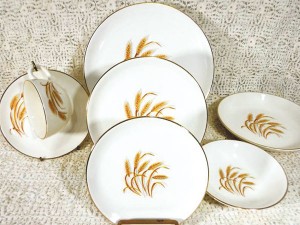Mid 20th century America was a time for entertaining at home. A dinner party with the boss, a bridge game with the girls and even a cookout with the family was a time to serve guests with style. The Summer of 2020 finds us returning to those simpler times as entertaining small groups of friends in the comfort of our homes is back in vogue. Planning a get together? Here are some of the most popular table settings of the MCM period to help you welcome your guests.
The Homer Laughlin China Company reigns as one of the most prolific of all the American dinnerware manufacturers of the 20th century. While they are responsible for many popular patterns, it is their Fiestaware line, produced from 1936-1972, that many consider their most successful. Fiesta was originally issued with 36 different pieces including basic table service. The 1936 line featured five colors: cobalt blue, light green, yellow, ivory, and a bright orange color that is known as Fiesta Red. Turquoise, though often considered one of the original colors, was introduced the following year. In 1943 Fiesta Red was dropped from the line as the production of the red glaze required the use of uranium which was needed for the war effort. It would remain absent until March of 1959. In 1972 Homer Laughlin changed their basic glaze formula eliminating the use of uranium in manufacturing. Fiesta is still in production and remains a quality line of dinnerware. However, serious collectors have very little interest in pieces post-1972 and tend to focus mainly on the 5 original colors.
Give-away promotions were extremely popular in the 1950s and 60’s and Homer Laughlin stepped up to meet the demand. Dishes were found in boxes of laundry detergent and oatmeal as well as given out at local gas stations and movie theaters. Many patterns were promoted in this manner, but none more successfully than HL’s “Golden Wheat.” Produced from 1949-1966, this tableware, which features a large windblown shock of wheat on a creamy white background, was one of the most popular giveaways of the day. The collaboration between the failing detergent company and Homer Laughlin saved DUZ detergent from extinction and made “Wheat” dishes on of the most collectible patterns of the 1950s and 60s.
In 1934 a group of Cambridge, Ohio business men formed the Universal Potteries Company. Their product lines included water jugs, refrigerator storage dishes and casserole dishes, but they are most highly recognized for two of their early dishware patterns, Cattail and Ballerina. Cattail (1934-1956) with its plain white background decorated with a black and red cattail in the center, appeals to those who like a classic retro design. Ballerina (1940-1959) with its bold colors and simple lines has a more MCM appeal. Universal closed its doors in 1960 but both Cattail and Ballerina remain a mainstay at the antique malls of 2020.
One of the most successful lines of 20th Century tableware was not made of china, but rather of melamine resin plastic. As popular now for as they were in 1953, Melmac dishes are colorful, sturdy and great for cookouts and casual outdoor dining. Collectors are particularly attracted to the work of noted designer, Russell Wright. His first line, “Residential,” was one of the most successful lines of 1950s Melmac, garnering over $4 million in sale in 1957. Slightly harder to find, and considerably more expensive, is his “Ming Lace” pattern with actual jade orchid tree leaves tinted and embedded inside its translucent pieces. Sales for this pattern soared after it was used in the Beatles 1965 movie “Help” and it remains a favorite in today’s market.
As you prepare for your summertime company why not forgo the “Pioneer Woman” and “Pfaltzgraff” and give your guests a dinner to remember with a table set MCM style! Until next time . . Linda
Linda Kennett is a professional liquidation consultant specializing in down-sizing for seniors and the liquidation of estates. Linda is not taking clients at this time.



